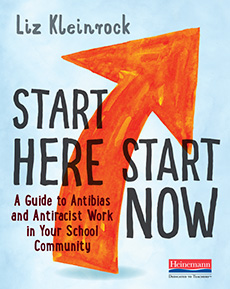Implementing Antibias and Antiracist Work
Start Here Start Now: A Guide to Antibias and Antiracist Work in Your School Community
By Liz Kleinrock
(Heinemann, 2021 – Learn more)
By Jeny Randall

I teach at a predominantly white school in Upstate New York. While I have been engaged in diversity, equity and inclusion work for years, facilitating difficult conversations about race in my classroom still feels fraught. I found Liz Kleinrock’s Start Here, Start Now a hopeful and inspiring book.

Respect is at the core of this book: Kleinrock states, “Schools and educators have a responsibility to ensure that students understand how our society operates, and how to communicate with people across the political and cultural spectrum.” (p. xxvii)
Kleinrock skillfully balances her coaching. She provides information and direction without condescending or assuming that her readers have specific background knowledge. She shares her missteps as well as her successes, shining light on both in a way that allows the reader to learn along with her. She also does not shy away from challenging topics such as privilege or saviorism. She advocates for a space “for all students to develop awareness of their identities and be comfortable talking about who they are.” (p.107)
As an ELA teacher, I strive to model a writing life for my students and engage in rich discussions with them about the books they are reading because I have read them too.
In approaching ABAR work in the classroom, Kleinrock likewise urges the reader to “start with yourself.” She offers strategies such as identity mapping (p. 3) that teachers can use to explore their own identities and biases as well as helping their students on the same journey.
Strategies for the classroom and beyond
Kleinrock explores strategies and language for facilitating difficult conversations, working with parents, and gaining support of an administration. Each of these chapters provides examples, strategies, and resources for finding success. A “don’t reinvent the wheel” section at the end of each chapter offers additional resources.
The chapter “What does ABAR look like if all or most of my students are white” stood out strongly for me. Not only did I find lessons and strategies I can implement immediately in my classroom, but I also felt empowered and hopeful.
In “What does Developmentally Appropriate ABAR Look Like for Younger Students,” Kleinrock illustrates how children as young as two and three make decisions based on race. Given that children are both aware and curious, Kleinrock suggests ways we can break down more complex topics into their building blocks (e.g. “Fair vs. Equal” and defining “consent”) and use them as important developmental stepping stones to more complex conversations in older grades. In a sidebar Anna Hindley is quoted as saying, “If children aren’t having conversations that are thoughtful with adults that are helping them understand…then they’re going to fill in the blanks themselves.”
Lessons and more
Kleinrock advocates for viewing ABAR as a lens for all subjects. As “neither an add-on to your curriculum nor a separate block on your agenda,” she models how to use ABAR as a lens for teaching any curriculum or mandated standards.
She also shows how to make time for ABAR work by providing lesson plan templates, sample lessons, and standards alignment. For teachers working with mandatory texts, Kleinrock unpacks the way many texts provide rich grounds for discussion.
ABAR work is a community effort in which we benefit from hearing a variety of experiences and voices. Kleinrock draws in multiple perspectives through her Keep in Mind sidebars. These highlight the voices of teachers and administrators who work in a wide array of schools and provide honest examples and tips from people engaged in ABAR work across the country.
A final chapter explores what ABAR looks like in what we perceive to be the “neutral” disciplines of science, math and STEM, showing how bias appears in unexpected ways and that by raising our own awareness and that of our students, we can create a more inclusive learning space.
Reaching a wide range of educators with compassion
In Start Here, Start Now, Liz Kleinrock has crafted a well-written book that will be relevant to a wide range of educators. Classroom teachers, administrators, and specialists across grade-levels will benefit from Kleinrock’s insights. Whether readers are looking to raise their own awareness, develop skills for discussing challenging topics, or embark on creating an ABAR classroom, they will find strategies and ideas presented with compassion in Start Here, Start Now.
Reference
Will, M. (2020). Still Mostly White and Female: New Federal Data on the Teaching Profession. Education Week. https://www.edweek.org/leadership/still-mostly-white-and-female-new-federal-data-on-the-teaching-profession/2020/04
Jeny Randall is the Middle School Director and LA teacher at Saratoga Independent School in New York State. She also oversees the curriculum and program development for grades 6 – 8. Jeny is a Responsive Classroom certified teacher. Outside of school, Jeny teaches yoga, reads whatever students send her way, and spends time with her family, outside if possible.



































